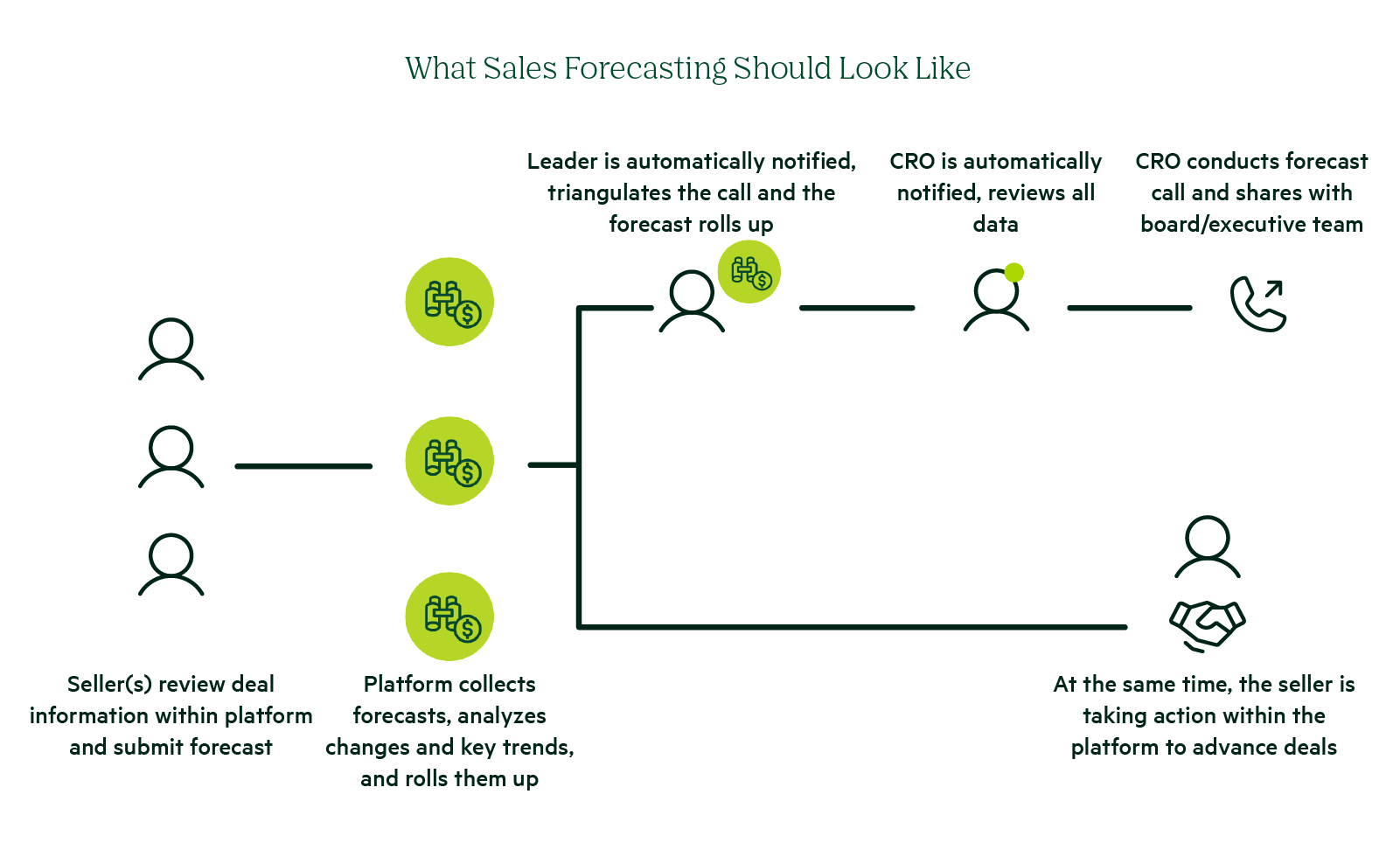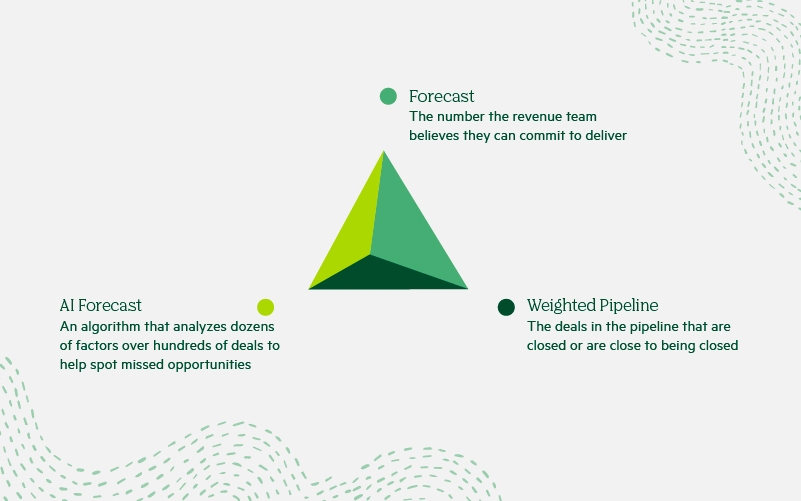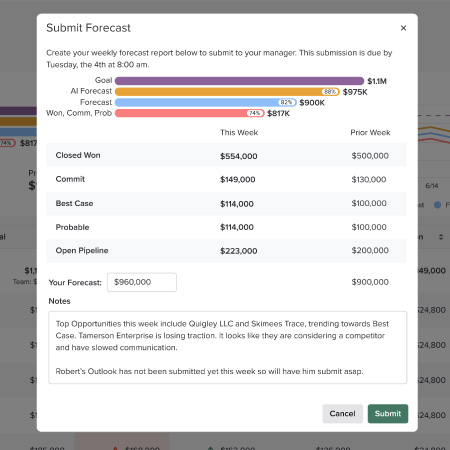Forecasts Should Be Roadmaps for Action
Updated:
Published:

Forecasting is way more than just “the number.” Done well, it’s a map of soft spots in your business and insight into what to do about them. Good forecasting yields a plan of attack to close more deals. It’s a process of combining deal-level visibility, AI, and intuition to drive the right business conversations that drive the right action. Oh, and you also get “the number.”
Forecasting is one of the most antiquated, difficult and yet critical business processes. With all the innovation that’s come to the business and personal world, for most people the biggest innovation in forecasting in twenty years has been an online spreadsheet. But forecasting is something every sales team either does — or knows they should do — in order to plan their business and stay on track to hit goals.
If forecasting is hated in most businesses, it’s also undervalued. Figuring out “the number” the business will hit helps the CFO and the CEO, but it doesn’t do much to help the sales team beyond showing accountability. It’s something sales teams spend a tremendous amount of time on for very little return.
Forecasting can be so much more. It can be a roadmap for action. With the right insight into the business in flight, all the way down to the deal level and activity on that deal, teams can use the forecast to build a plan: engage the right deals, in the right way. Focus on winnable deals. Shore up areas of softness.
To do that, Forecast has to be a partner to sellers. It provides a workflow that sellers don’t hate, right in the places where your team already works. It builds on data already in your systems so you get real-time visibility. It offers a view of everything from an AI forecast to deal-level detail, so you can triangulate on the number and understand the possibilities. And finally, it’s not a disconnected thing you do once a week or once a month—it’s built right into your sales execution system, so as you understand more about your deals in flight, you can act on them.
Download the Ultimate Guide: The Future of Sales Forecasting.
Forecasting is a Broken Process
Most sales teams hate building the forecast. And for good reason.

The typical process looks like this: someone, usually revenue operations, emails a spreadsheet to teams and asks for an updated forecast. Reps scramble to find all their deal information, fill in numbers, and maybe sandbag a few deals because they’re not sure how things will go. Then managers follow up with those last reps who still need to input their numbers, try to adjust for the reps they know under or over-deliver, and then probably do it again because they lost track of what deals were in or out. Then RVPs follow a similar process to fill in numbers. It’s messy, it takes a lot of time, and reps and managers end up providing forecasts they don’t totally believe in.
Then, at the forecast meeting, the CRO reviews the forecast and asks a bunch of questions about how the number got created. No one’s sure of the answers because it’s so hard to match the record of the deals to the forecast spreadsheet. They try to dig into a deal, but there’s no information in the CRM. They start texting, slacking and calling reps to get that information directly. The team spends more time trying to understand the spreadsheet than having real business conversations. They rarely get to actions they can take to influence the deals in flight.
Finally they make a call and have “the number.”
This process is broken. It’s manual and time consuming. It’s done in spreadsheets, not where sellers are doing their work. “The number” gets dissociated from the deals that make up the number, so it’s virtually impossible to drill back to what’s happening in those deals. And “the number” doesn’t help the sales team strategize about which deals to prioritize or where critical deal gaps exist. The visibility comes too late to know which deals to prioritize to get to a better outcome for the quarter.
It’s bad enough that all of this is frustrating. But at the end you’re left with a number that you don’t quite believe in, and – most importantly – isn’t doing anything to help you get results. Even if you manage to call “the number” right, your forecast is under-delivering.
Modern Forecasting is an Action Plan for Closing Business
There is a better way. Done well, forecasting can help your team understand its business better. It can provide a path to affect outcomes and drive a better number. It can be part of the sales workflow, so that sellers don’t waste precious time manipulating spreadsheets and instead have data in their workflow to provide insight they otherwise wouldn’t.

A modern forecasting system must be part of your sales execution system. The information about your deals in flight – who’s contacting the customer, what meetings were had and what was said, how the customer responds — is the foundational information that your forecast rests on. If you’re using a sales engagement platform, all of that activity is already being tracked automatically, without your sellers needing to spend time logging their activities. Meetings and calls are recorded and searchable so you can review that pivotal moment with the buyer.
All that data helps you understand your deals, and your deals build up to your forecast. Having forecasting and engagement in the same system means really knowing what’s happening in each deal. It also means a much richer forecast, with less time spent. And that your
Our team spent hundreds of hours with customers understanding these problems deeply. And not only that, we live these problems in our own business as well. The perspective we developed led us to focus on three critical things when we built Salesloft forecasting.
1. A plan for action (not just a way to generate a number).
Forecasting under-delivers when the end result is just a number. The end result should be a set of actions you can take to deliver better results. To do that, you need to not only see a number, but you need to see areas of softness and strength, important deal gaps, and opportunities. You need to recognize that the East team will need your support this quarter, but that the West will probably overachieve. You need to know where to spend your team’s time most productively to get over the line.
2. Relevant data helps you triangulate. You “own the number.”
To make a good call, you need a lot of data. Managers need to be able to drill down to individual reps, and to the deals they are working, and even the recent activity within those deals. CROs need to see the rollup of all the calls of all teams, know what’s already closed in the quarter, and know where they’re heading. To land on a number you can be confident in, you need to triangulate across the AI forecast, weighted pipeline, and human insight. This triangulation should happen in an intuitive, visual way that builds on real-time data and doesn’t require the sales ops team working over the weekend to build charts.

AI is a big part of this triangulation. Advanced models can help you predict where you will land and see where you need to do more. With good data, an AI model can be an essential partner in helping you understand your business. But sales teams don’t have a lot of time to build aI models. That’s why AI is the most useful when it is embedded into a forecast system.
One question that sales leaders are always asking is, “What’s changed?” It’s critical to know that a deal is pushed, especially if it has pushed out twice before. Or that a deal got bigger or smaller. These deal-level changes to the forecast hold a tremendous amount of information but are usually lost by the time the forecast gets to the Chief Revenue Officer, especially if it’s in a spreadsheet. And CRMs are notoriously bad at telling you what changed – they can only tell you what today’s snapshot looks like. A forecasting system has to be able to capture this critical data if it’s going to help you understand what’s happening in your business.
No matter how good the AI or all the relevant data, it’s ultimately the team that makes the call. A forecasting system should provide all the data and a way to triangulate across it. But ultimately, sellers, managers and the CRO – not AI – need to feel ownership of the number. Your system should support people in making the call, not force a forecast on the team. Ideally, it should let managers and reps provide context–the kind of context usually provided verbally or in a long email chain.
3. Forecasting as Part of the Sales Workflow, Not an Additional, Swivel-Chair Activity
If you have a sales team it’s probably because you believe that people providing guidance to buyers is important to your business. Sellers can do things computers can’t, like connect with prospective customers, strategize about opportunities and partner with customers on creating value. So you want your sales team spending time on those things, not tabbing between computer screens and inputting numbers into spreadsheets.
Having forecasting right in your sales workflow is a huge win for sellers. With forecasting capability where they already work, they get the benefit of a familiar interface, less back and forth, and fewer logins. They have the information they need about each deal right there — as they build their forecast – so they can make a better call. Deal gaps become obvious, and reps can address them before the roll up to the CRO. And, critically, they can take action right then and there – email a prospective customer, add someone to a follow-up cadence, or text a champion. It’s all in the same system, right in the flow of work. It’s faster and less frustrating. It lets your sellers get back to selling.

If Your Forecasting Process is Taking More Than It’s Giving, Look for Another Way
If you’re wasting valuable selling time building a forecast that doesn’t help you understand and take action in your business, consider a different approach. Look for a system that gives you data in the workflow, right where you already work. Look for strong AI modeling, the ability to see deal changes and access to drill into every deal. Forecasting should be your secret weapon in strategizing about your business.





























